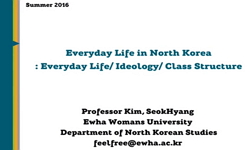The biogeography and diversity patterns of the marine bivalve molluscan fauna of the East Sea coast of South Korea are analyzed. The total species richness of the continental Korean bivalve fauna, excluding insular regions (Dok-do and Ullung-do), is 3...
http://chineseinput.net/에서 pinyin(병음)방식으로 중국어를 변환할 수 있습니다.
변환된 중국어를 복사하여 사용하시면 됩니다.
- 中文 을 입력하시려면 zhongwen을 입력하시고 space를누르시면됩니다.
- 北京 을 입력하시려면 beijing을 입력하시고 space를 누르시면 됩니다.
https://www.riss.kr/link?id=A104218085
-
저자
Lutaenko, K. (Far East Branch of the Russian Academy of Sciences) ; Noseworthy, R.G. (제주대학교)
- 발행기관
- 학술지명
- 권호사항
-
발행연도
2014
-
작성언어
English
- 주제어
-
등재정보
KCI등재
-
자료형태
학술저널
-
수록면
281-293(13쪽)
-
KCI 피인용횟수
1
- DOI식별코드
- 제공처
-
0
상세조회 -
0
다운로드
부가정보
다국어 초록 (Multilingual Abstract)
The biogeography and diversity patterns of the marine bivalve molluscan fauna of the East Sea coast of South Korea are analyzed. The total species richness of the continental Korean bivalve fauna, excluding insular regions (Dok-do and Ullung-do), is 304, and from north to south the species richness of bivalves increases showing a clear gradient: Gangwon, 143 species → Gyeongbuk, 131 → Gyeongnam, 183. A zonal-geographical analysis of the entire fauna shows that the great majority are warm-water mollusks, constituting 77% (subtropical, 37%, tropical-subtropical, 30%, subtropical-boreal, 10%), The number of boreal (low-boreal, widely distributed boreal and circumboreal) species is lower, 19%, whereas boreal-arctic mollusks have only 4%. This demonstrates that the bivalve molluscan fauna of the eastern coast of Korea is subtropical, and has more affinities to the fauna of the East China Sea than to the northern East Sea. Separate analysis by provinces shows the increasing role of warm-water mollusks from north to south. While tropical-subtropical and subtropical species constitute 47% (68 species) in Gangwon, their dominance increases to 71% (93 species) in Gyeongbuk, and to 80% (148 species) in Gyeongnam. The Gyeongnam bivalve fauna is the most diverse in species composition and has the largest number of “endemics” (species known only from this province), 46%. The Gangwon fauna also contains many “endemics”, up to 40%, while Gyeongbuk is an intermediate zone with low “endemicity”, only at one-fifth of the regional fauna, and has the most species in common among the three provinces.
참고문헌 (Reference)
1 A Catalogue of Molluscan Fauna in Korea, "한국산 연체동물 목록" 한국패류학회 18 (18): 93-217, 2002
2 Lutaenko, K.A., "Zonal-biogeographical analysis of bivalve molluscan faunas in three major areas of the western Sea of Japan" 89-94, 2012
3 Nishimura, S., "The zoogeographical aspects of the Japan Sea" 13 : 35-79, 1965
4 Kwon, Y.W., "The Geography of Korea" National Geographic Information Institute 432-, 2010
5 Sedova, L.G., "Stock and distribution of the scallop Mizuhopecten yessoensis in the southwestern part of Peter the Great Bay" 155 : 76-87, 2008
6 Ito, K., "Shell species caught [by] S/S Rokko-Maru off the coast [of] Ishikawa Prefecture" 4 : 1-179, 1986
7 Hall, C. A., "Shallow-water marine climates and molluscan provinces" 45 : 226-234, 1964
8 Sedova, L. G., "Resources of commercial bivalve molluscs in Peter the Great Bay" 147 : 320-334, 2007
9 Lutaenko, K.A., "On the bivalve molluscan fauna of North Hamgyong Province (North Korea)" 18 : 63-78, 2014
10 Min, D. -K., "Mollusks in Korea" Min Molluscan Research Institute 566-, 2004
1 A Catalogue of Molluscan Fauna in Korea, "한국산 연체동물 목록" 한국패류학회 18 (18): 93-217, 2002
2 Lutaenko, K.A., "Zonal-biogeographical analysis of bivalve molluscan faunas in three major areas of the western Sea of Japan" 89-94, 2012
3 Nishimura, S., "The zoogeographical aspects of the Japan Sea" 13 : 35-79, 1965
4 Kwon, Y.W., "The Geography of Korea" National Geographic Information Institute 432-, 2010
5 Sedova, L.G., "Stock and distribution of the scallop Mizuhopecten yessoensis in the southwestern part of Peter the Great Bay" 155 : 76-87, 2008
6 Ito, K., "Shell species caught [by] S/S Rokko-Maru off the coast [of] Ishikawa Prefecture" 4 : 1-179, 1986
7 Hall, C. A., "Shallow-water marine climates and molluscan provinces" 45 : 226-234, 1964
8 Sedova, L. G., "Resources of commercial bivalve molluscs in Peter the Great Bay" 147 : 320-334, 2007
9 Lutaenko, K.A., "On the bivalve molluscan fauna of North Hamgyong Province (North Korea)" 18 : 63-78, 2014
10 Min, D. -K., "Mollusks in Korea" Min Molluscan Research Institute 566-, 2004
11 Golikov, A.N., "Molluscs of the Possjet Bay (the Sea of Japan) and their ecology" 42 : 5-154, 1967
12 Briggs, J. C., "Marine Zoogeography" McGraw-Hill Book Co. 1974
13 Willig, M. R., "Latitudinal gradients of biodiversity: pattern, process, scale, and synthesis" 34 : 273-309, 2003
14 Rex, M. A., "Large-scale biogeographic patterns in marine mollusks: a confluence of history and productivity?" 86 : 2288-2297, 2005
15 Amano K., "In:Migrations of Organisms. Climate, Geography, Ecology" Springer 2005
16 Lutaenko, K.A., "In: Marine Biodiversity and Ecosystem Dynamics of the North-Western Pacific Ocean" Science Press 160-188, 2014
17 Kafanov, A. I., "Ichthyofaunistic biogeography of the Japan (East) Sea" 27 : 915-933, 2000
18 Honma, Y., "Fauna and flora in the waters adjacent to the Sado Marine Biological Station, Niigata University; supplement 2" Annual Report of the Sado Marine Biological Station, Niigata University 13-30, 1995
19 Honma, Y., "Fauna and flora in the waters adjacent to the Sado Marine Biological Station, Niigata University: supplement 1. Annual Report of the Sado Marine Biological Station"
20 Honma, Y., "Fauna and flora in the waters adjacent to the Sado Marine Biological Station, Niigata University" 8 : 7-81, 1978
21 Ito, K., "Distribution of molluscan shells in Wakasa Bay, Japan Sea" 40 : 79-211, 1990
22 Yoo, S.K., "Distribution of drifting larvae of scallop, Patinopecten yessoensis, in the Yeong-il Bay" 14 : 54-60, 1979
23 Kolpakov, E.V., "Distribution and growth of bivalve mollusc Mercenaria stimpsoni in Inokov Bay (north Primorye)" 136 : 197-204, 2004
24 Xu, F., "Characteristics of bivalve diversity in typical habitats of China seas" 19 (19): 716-722, 2011
25 Lutaenko, K.A., "Catalogue of the Living Bivalvia of the Continental Coast of the Sea of Japan (East Sea)" Dalnauka 247-, 2012
26 Higo, S., "Catalogue and Bibliography of the Marine Shell-bearing Mollusca of Japan" Elle Scientific Publications 749-, 1999
27 Scarlato, O. A., "Bivalve mollusks of temperate latitudes of the western portion of the Pacific Ocean"
28 Lutaenko, K. A., "Bivalve mollusks of Ussuriysky Bay (Sea of Japan)" 10 : 46-66, 2006
29 Konstantin A. Lutaenko, "Bivalve mollusks in Ulsan Bay (Korea)" 한국패류학회 30 (30): 57-77, 2014
30 Lutaenko, K.A., "Bivalve molluscan biogeography of the Japan Sea: an overview" 1-6, 2010
31 Lutaenko, K., "Bivalve Mollusks in Yeongil Bay, Korea. 2. Faunal Analysis" 한국패류학회 22 (22): 61-82, 2006
32 Kafanov, A. I., "Bivalve Molluscs and Faunistic Biogeography of the Northern Pacific" Far East Branch, USSR Academy of Sciences 195-, 1991
33 Xu, F., "Bivalve Mollusca of China Seas" Science Press 333-, 1997
34 Kussakin, O. G., "Biogeography of isopod crustaceans in the boreal Pacific" 46 : 620-639, 1990
35 Ryu, S. -H., "Biodiversity of marine invertebrates on rocky shores of Dokdo, Korea" 51 (51): 710-726, 2012
36 Rho, B. J., "An analysis of invertebrate community at the tidal and subtidal zone in Onsan Bay with regard to the effect of pollution" 15 : 79-88, 1997
37 Yi, S. K., "A study on the subtidal benthic community in Ulsan Bay, Korea" 4 : 17-26, 1982
38 Kuroda, T., "A catalogue of molluscan shells of Sado Island, Sea of Japan" 1 : 13-32, 1957
39 Noseworthy, R.G., "A Catalogue of the Mollusks of Jeju Island, South Korea" 한국패류학회 23 (23): 65-104, 2007
동일학술지(권/호) 다른 논문
-
Condition index와 혈구 apoptosis 분석을 통한 서해안 굴, Crassostrea gigas의 건강도 평가
- 한국패류학회
- 임현정
- 2014
- KCI등재
-
- 한국패류학회
- 김우진
- 2014
- KCI등재
-
이원면 굴, Crassostrea gigas 양식어장의 월별 식물플랑크톤 종조성 및 수질환경 변화
- 한국패류학회
- 김수경
- 2014
- KCI등재
-
수하식 큰가리비 양식의 채롱간 조류의 흐름 간섭현상 규명
- 한국패류학회
- 김현영
- 2014
- KCI등재
분석정보
인용정보 인용지수 설명보기
학술지 이력
| 연월일 | 이력구분 | 이력상세 | 등재구분 |
|---|---|---|---|
| 2026 | 평가예정 | 재인증평가 신청대상 (재인증) | |
| 2020-01-01 | 평가 | 등재학술지 유지 (재인증) |  |
| 2017-01-01 | 평가 | 등재학술지 유지 (계속평가) |  |
| 2013-01-01 | 평가 | 등재 1차 FAIL (등재유지) |  |
| 2010-01-01 | 평가 | 등재학술지 선정 (등재후보2차) |  |
| 2009-01-01 | 평가 | 등재후보 1차 PASS (등재후보1차) |  |
| 2008-01-01 | 평가 | 등재후보학술지 유지 (등재후보1차) |  |
| 2007-01-01 | 평가 | 등재후보학술지 유지 (등재후보1차) |  |
| 2006-01-01 | 평가 | 등재후보학술지 유지 (등재후보2차) |  |
| 2005-05-30 | 학술지명변경 | 한글명 : 한국패류학회지 -> The Korean Journal of Malacology |  |
| 2005-01-01 | 평가 | 등재후보 1차 PASS (등재후보1차) |  |
| 2004-01-01 | 평가 | 등재후보학술지 유지 (등재후보1차) |  |
| 2003-01-01 | 평가 | 등재후보학술지 선정 (신규평가) |  |
학술지 인용정보
| 기준연도 | WOS-KCI 통합IF(2년) | KCIF(2년) | KCIF(3년) |
|---|---|---|---|
| 2016 | 0.33 | 0.33 | 0.34 |
| KCIF(4년) | KCIF(5년) | 중심성지수(3년) | 즉시성지수 |
| 0.35 | 0.34 | 0.331 | 0.1 |




 KCI
KCI






